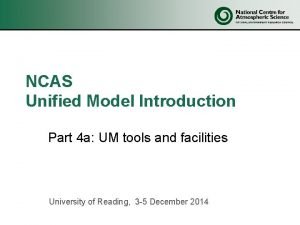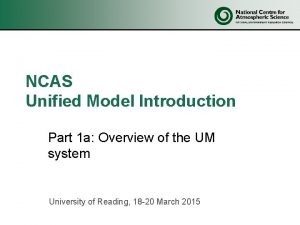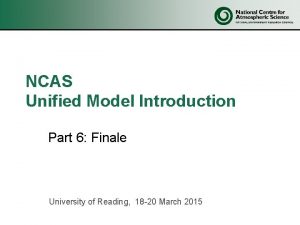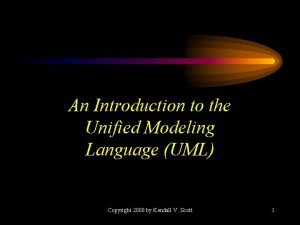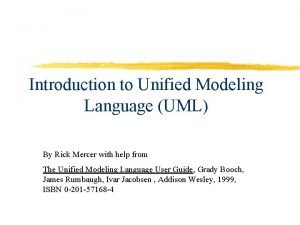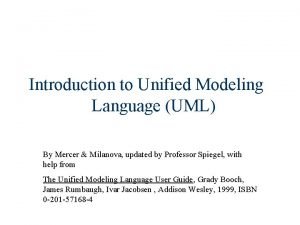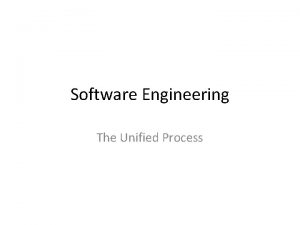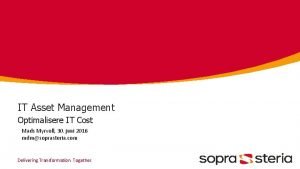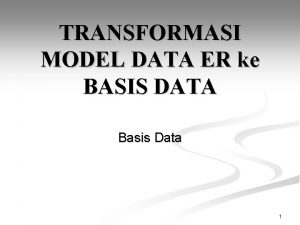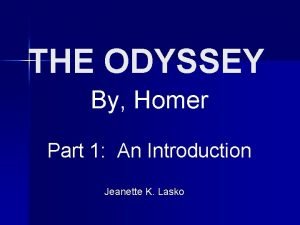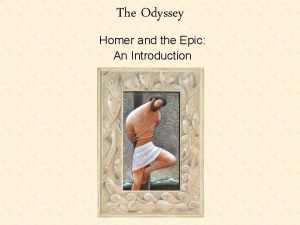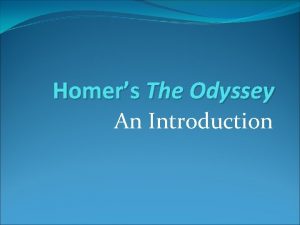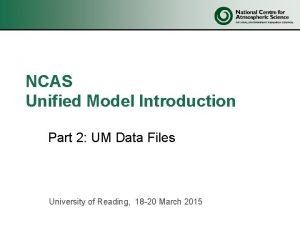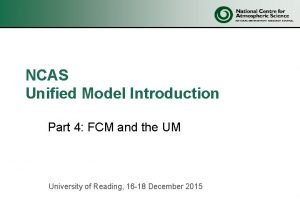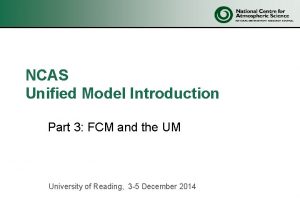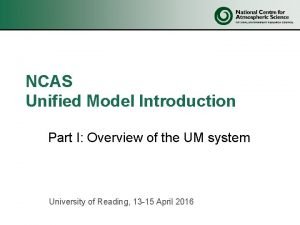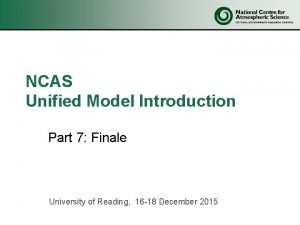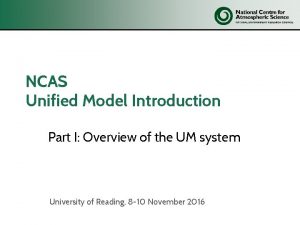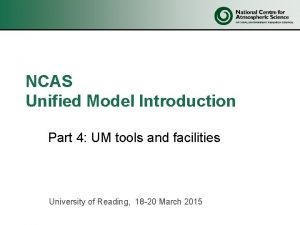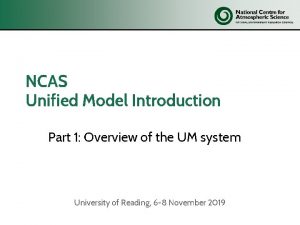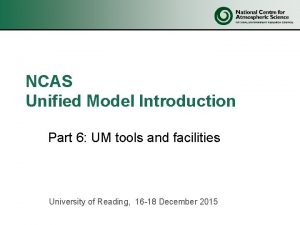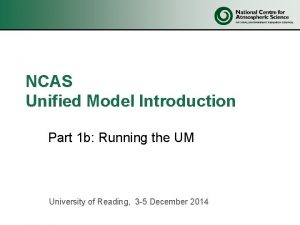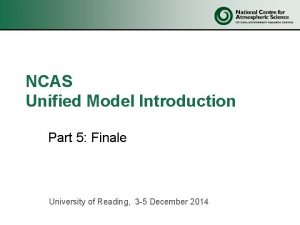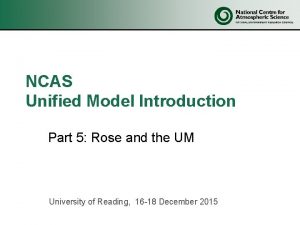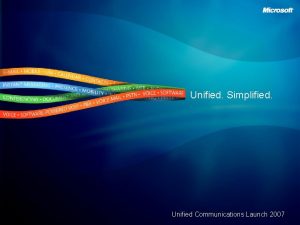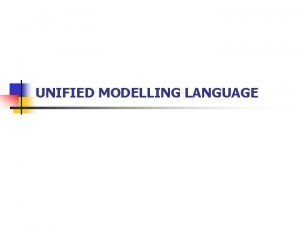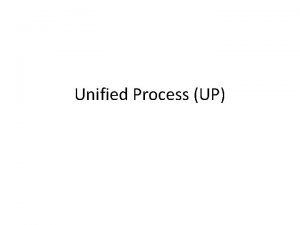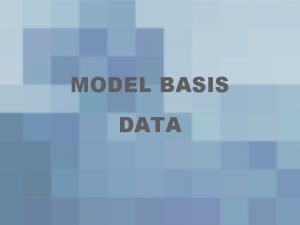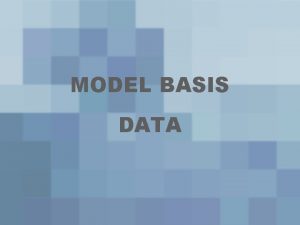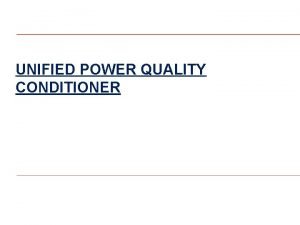NCAS Unified Model Introduction Part 3 UM Data


































- Slides: 34

NCAS Unified Model Introduction Part 3: UM Data Files University of Reading, 16 -18 December 2015

Contents • UM file types • Model input • Model output • Limited Area Models • NEMO and CICE 2

UM and PP formats There can be confusion about these two types of UM-related files. UM format • The format read and written by the model. • Direct access files that consist of a primary header containing pointers to a series of secondary headers that then point to the data: – Implies mixed integer/real arrays conventionally handled with equivalence – Assumes that levels for a given variable are contiguous • Described in document F 3: http: //cms. ncas. ac. uk/wiki/Docs/Met. Office. Docs PP format • Produced from UM files for data analysis (not used by the model). • Sequential files (header, data, header, data). • Files from the BADC and UKMO archive may be in this format. 3

UM files Files in Files out Initial files (also called start files or dumps) Restart files (or dumps) Lateral boundary conditions (LBCs) Ancillary files (fixed, forcing) Post processing diagnostic files (also called fields files) Control Climate means All model files are in UM format, but there are slight variations between restart files, ancillaries and fields files (see UM doc F 3). 4

(CF-)Net. CDF Network Common Data Form: • • Portable and self-describing data format. Various supported and external libraries and tools. Widely used and a standard format for many scientific communities. http: //www. unidata. ucar. edu/software/netcdf/ Climate and Forecast conventions: • • Set of standards for describing data (metadata). Definitive explanations of data variables (standard names). Definitions for temporal and spatial properties of the data. http: //cfconventions. org/ 5

Net. CDF and the UM • When you might come across Net. CDF: – Input data sets may be in Net. CDF (e. g. CMIP 5 scenarios). – It can be more convenient to use Net. CDF for analysing or sharing data. – NEMO and CICE read and write Net. CDF files. • There are tools for converting between (CF-)Net. CDF and UM/PP formats. • NCAS are working on a project to write CF-Net. CDF directly from the UM. 6

• UM file types • Model input • Model output • Limited Area Models • NEMO and CICE 7

UM start dumps • Start dumps are available on the National Computing Service (ARCHER) for standard resolutions under: /work/n 02/hum ($UMDIR) • Restart dumps from other UM jobs can be used. • For NWP, particular dates are available from the UK Met Office. Contact the NCAS modelling helpdesk: http: //cms. ncas. ac. uk/wiki/Cms. Helpdesk 8

Start dates • For climate runs the start date is largely irrelevant • But for NWP experiments or case studies, the start date matters • The UKMO archives only the last ~18 months of analyses which are used as start dumps. To start the UM from other dates, you need to use ECMWF data and convert this to a UM start dump. • Starting from ECMWF data is available on the national HPC services. – For advice on starting from ECMWF data contact the helpdesk. – Example reconfiguration jobs are available under the “umui” owner. 9

The UM reconfiguration (i) The reconfiguration is a standalone program which modifies (“reconfigures”) UM atmosphere or ocean start files to produce a new start file. • This can be on a new grid (not for ocean files) – with different horizontal area – and/or different horizontal resolution – and/or different vertical resolution – if no new data is included, data from the original start file is interpolated to the new model grid/domain; • It can also include different data fields from ancillary files – e. g. new orography data – e. g. new ozone data 10

The UM reconfiguration (ii) • The reconfiguration is part of the UM code base but it has its own compilation stage to produce its own executable. • It runs on multiple processes (usually less than the main UM). • It can be run independently or immediately before a UM model run. • Use the reconfiguration to: – – Upgrade a start file from an earlier code version Add fields including user-defined fields Overwrite existing fields Change resolution (not with ocean files) 11

UM ancillary files • Ancillary fields describe externally prescribed conditions to be imposed on the model fields. – These may be time varying, fixed or apply only to the initialisation. • They may be – in the start dump already (standard ancillary fields) – replaced in the start dump (modified ancillary fields) – or they can be added to the start dump (user ancillary fields) • The user needs to consider: – the horizontal and vertical resolution – the time variation – the 360 day/Gregorian calendar switch in the file header • In the UMUI ancillary file names and directories may be specified using environment variable. These are defined in an “ancillary versions file”: Atmosphere -> Ancillary and input data files -> In file related options -> Ancillary versions file 12

Standard ancillary files Ancillary fields are grouped into files. Fixed: • Atmosphere -> Ancillary and input data files -> Other ancillary files and Lateral Boundary files • E. g. , orography, land-sea mask, land fraction Climatologies: • Atmosphere -> Ancillary and input data files -> Climatologies & potential climatologies • Standard files are available on the national HPC services: Ozone Shine and Li, Cariolle, SPARC SST / sea ice GISST, Had. ISST Soil fields AMIP 13

Example ancillary field 14

Control files • The SW and LW radiation code use “spectral” files • Spectral data for the radiation scheme are generated by a separate preprocessing package and are stored in a spectral file. – This is not a simple matter and users will not normally generate their own spectral files. • Standard spectral files are available in the “ctldata/” directory of the UM installation. – Different spectral files are available on the national HPC services. • Spectral files are not in UM format but are Fortran namelists, e. g: &R 2 SWSP L_PRESENT(0)=. TRUE. , N_BAND=6, N_ABSORB=4, N_AEROSOL=13, TYPE_ABSORB=1, 2, 3, 7, TYPE_AEROSOL=1, 2, 3, 4, 6, 10, 11, 12, 13, 15, 16, 23, 24, 15

• UM file types • Model input • Model output • Limited Area Models • NEMO and CICE 16

UM restart dumps • Instantaneous dumps of the main model variables, written at regular intervals. – To restart the model for when things go wrong so that the run can be continued rather than starting again. – Start files for running long runs in ‘chunks’ – The basis for climate meaning. • UMUI window: – Atmosphere -> control -> post-processing, dumping and meaning • All restart dumps will be kept unless you set: – Post processing -> main switch & general questions • automatic post processing : yes • delete superseded restart dumps : yes – This works with and without archiving 17

Automatic resubmission 0 1 NRUN 2 3 4 5 6 7 8 years CRUN – automatic resubmission • Always keep the same restart frequency throughout an experiment and for experiment inter-comparisons. • To run a long climate experiment - set the restart dump frequency to a ‘reasonable’ rate run the first chunk, check results are ok select CRUN (may be a hand-edit) resubmit the job • Automatic data archiving, based on the UKMO system, has been implemented on the national HPC services. 18

Automatic archiving Output from the UM ARCHER temporary space /work MONSoo. N temporary space /projects RDF /nerc MASS archive JASMIN Your home institution 19

Post processing files • Output in fields file format (soon to be CF-net. CDF) • Diagnostics set up via STASH and written to a “post processing unit”: – Atmosphere -> STASH • Post processing unit file sizes depend on options selected in the UMUI: – Post processing -> initialisation and processing – Options include • Profile 0: unpacked • Profile 5: new standard climate packing – Packed files save space when archiving. • Reduce file sizes at the end of the run (not if the run is to be continued) using “umpack”. This gets rid of padding and any extra headers. 20

Configuring diagnostics 21

Configuring post processing files Unit number for fields files 60 – 69 Files labelled xxaabo. pp 4 in $DATAW if not initialised Files labelled xxaabo. pdxxxx in $DATAM if re-initialised File names calculated from the re-initialisation process 22

Climate Meaning • Climate runs using automatic resubmission, meaning the mechanism is safe over restarts. • Diagnostics can be tagged to be picked up by the climate meaning system via STASH. • Climate means are related to the dump frequency: – Atmosphere -> Control -> Post-processing, Dumping & Meaning -> Dumping and meaning -> NEXT – For example with a dumping frequency of 10 days, meaning periods of 3, 3, 4 and 10 will give: • • monthly (3 x 10 day) means seasonal (3 x 30 day) means annual (4 x 90 day) means decadal (10 x 360 day) means • File names will be of the form $RUNID. mm…, $RUNID. ms… 23

Climate meaning uses partial sum files to preserve precision across restarts xbtlba. dab 9 cb 0 xbtlb. apstmp 1 xbtlbo_s 2 b xbtlb. opstmp 1 xbtlb. phist xbtlba. pmb 9 dec xbtlba. dab 9 cl 0 xbtlbo. dab 9 cl 0 xbtlba_s 2 a xbtlbo. dac 0110 xbtlba. pab 9 dec xbtlba_s 2 b xbtlbo. dab 9 cb 0 xbtlbo. pdc 0 c 10 xbtlbo. pmb 9 dec 24

• UM file types • Model input • Model output • Limited Area Models • NEMO and CICE 25

Current resolutions • Operational global model: 17 km (previously 25 km) • Europe LAM: 4 km (operational) • On-demand LAM: 1. 5 km (forecaster requested) • Storm scale LAM: 1 km (research model) • Research LAMs: as low as 50 m © Crown copyright Met Office 26

Orography in the UM 12 km 4 km 1 km Height of model orography (m) 27

Lateral boundary conditions • LBC files are required by the Limited Area Model (LAM). • For standard areas (UK LAM and UK mesoscale): – Run the global UM to generate LBCs • 1024 x 769 L 70 – global forecast resolution Atmosphere -> control -> output data files -> LBCs out – Run LAM Atmosphere -> ancillary and input data -> other ancillary -> LBC • For higher resolution standard areas: – On puma under owner “umui” there are example jobs for • 12 km, 4 km and 1 km UK mesoscale – These need start and ancillary files, some available on national HPC services. 28

Outputting LBCs Specification of target grid 29

LAMPOS For non-standard areas: • choose new domain using LAMPOS (available on puma) • Create ancillary files: • Use the UKMO ancillary file creation system: CAP Available via the CMS web page • Run the global UM or larger LAM to generate LBCs • Run LAM • Seek help and advice from NCAS CMS 30

Horizontal domain specification Lat, lon in rotated grid Used to put equator of rotated grid In the centre of the LAM domain LAMPOS or BADC Grid utilities Obtained from CAP or reconfiguration 31

• UM file types • Model input • Model output • Limited Area Models • NEMO and CICE 32

Ocean and sea-ice NEMO files: • All in Net. CDF • Inputs cover full domain • By default one output file per process covering only that subdomain. – Construct global file after run using rebuild_nemo, e. g. : rebuild_nemo xdodto_CU 150_19780901_19780930_grid_T 16 • NEMO -> Scientific Parameters and Sections -> Links to NEMO model CICE files: • Restart files in binary format – There are tools to edit the start date and convert to Net. CDF – (contact NCAS-CMS for guidance) • All other inputs and outputs in Net. CDF (global files) • CICE -> Scientific Parameters and Sections -> Links to CICE model 33

ORCA grids • Used by NEMO and CICE • Tripolar grids • Standard resolutions: – – ORCA 2 (2°) ORCA 1 (1°) ORCA 025 (1/4°) ORCA 12 (1/12°) 34
 Ncas introduction
Ncas introduction Ncas introduction
Ncas introduction Ncas introduction
Ncas introduction Ncas application
Ncas application Ncas cms
Ncas cms Introduction to the unified modeling language
Introduction to the unified modeling language Introduction to unified modeling language
Introduction to unified modeling language Introduction to unified modeling language
Introduction to unified modeling language Unified engineering software
Unified engineering software Mads myrvoll
Mads myrvoll Introduction to data warehousing and data mining
Introduction to data warehousing and data mining Part whole model subtraction
Part whole model subtraction Part to part ratio definition
Part to part ratio definition Part part whole
Part part whole What is a technical description
What is a technical description Components of a bar
Components of a bar The phase of the moon you see depends on ______.
The phase of the moon you see depends on ______. Part to part variation
Part to part variation Transformasi model data ke basis data fisik
Transformasi model data ke basis data fisik The odyssey and epic poetry: an introduction, part 1
The odyssey and epic poetry: an introduction, part 1 The odyssey and epic poetry an introduction part 1
The odyssey and epic poetry an introduction part 1 Epic poetry definition
Epic poetry definition Hamlet part 1 an introduction to elizabethan theater
Hamlet part 1 an introduction to elizabethan theater First part of introduction
First part of introduction The odyssey and epic poetry an introduction part 1
The odyssey and epic poetry an introduction part 1 Who was homer
Who was homer The odyssey and epic poetry an introduction part 1 quiz
The odyssey and epic poetry an introduction part 1 quiz Introducing the odyssey
Introducing the odyssey Hamlet, part 1: an introduction to elizabethan theater
Hamlet, part 1: an introduction to elizabethan theater Tybalt act 1 scene 1
Tybalt act 1 scene 1 The odyssey and epic poetry an introduction part 1
The odyssey and epic poetry an introduction part 1 Mti rcog
Mti rcog The odyssey and epic poetry an introduction part 1
The odyssey and epic poetry an introduction part 1 The odyssey and epic poetry an introduction part 1
The odyssey and epic poetry an introduction part 1 What is the concentric zone model
What is the concentric zone model

